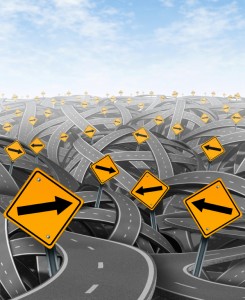If Crowdsourcing Is So Cool, Why Doesn’t Apple Do It?
I’m intrigued by crowdsourcing, the idea that you can send a complex task to an “undefined public” and get your work done quickly and efficiently. For instance, I enjoy teaching but I don’t like grading papers. So I’m thinking about crowdsourcing the task through a service like Amazon’s Mechanical Turk. In theory, I could send my grading guidelines and student papers to the “undefined public” that contracts with the Mechanical Turk, have them graded and returned in a few days all for a few bucks. I’ll let you know how it goes.
I’m also on the board of Beanstalk, a charitable organization that supports charitable organizations in Colorado. We have lots of grassroots leaders here who do amazing things in their local communities — like urban agriculture, food justice, childhood education, etc. — but don’t know much about the arts of fundraising or managing a non-profit. They’re dynamic individuals leading small-scale projects. They don’t have a national organization behind them. We back them up in multiple ways, including a crowdfunding website. In the past 18 months, the site has raised well over $300,000. (Check it out and give some money to your favorite projects).
Crowdsourcing and crowdfunding are important in my own daily activities. I’m a fan. I’m also a fan of Apple Computer and have been for almost 30 years. In all that time, Apple has never once asked me my opinion about their products. When Steve Jobs was asked how much market research went into the iPhone, he famously replied, “None. It’s not the consumers’ job to know what they want.”
So how does Apple stay ahead of the innovation curve and build products that we didn’t know we wanted? There are any number of accounts of how Apple works. (See for instance, Inside Apple or Insanely Simple or The Apple Experience). For today’s post, however, I’m going to stick to Steven Johnson’s account as found in Where Good Ideas Come From.
Johnson’s analysis revolves around the “coffeehouse” concept of innovation — very similar to the mashup concept that I’ve discussed on this website from time to time. In a coffeehouse, people and ideas connect, disconnect, and re-connect in “liquid networks.” Random connections supply ideas that then get mashed up — creating new ideas, concepts, and categories. Apple, on the other hand, has “adopted a fortress mentality toward the outside world.” As Johnson notes, “You won’t see Steve Jobs or Jonathan Ive crowdsourcing development of the next-generation iPhone.”
So how does Apple do it? Johnson writes that Apple’s “internal development process is explicitly structured to facilitate clash and connection between different perspectives. … [the] development cycle looks more like a coffeehouse than an assembly line.” Johnson describes most development cycles as linear processes where functionality is removed at each step. The designers come up with great ideas. The engineers who receive those ideas can deliver some of the functionality but not all of it. Manufacturing planners who receive the product plans can produce some of what’s wanted but not all of it. And so on in a declining circle.
Johnson suggests that Apple’s concurrent planning is “messier and more chaotic” but ensures that good ideas don’t get hollowed out. Instead, all the groups involved in creating products, “… meet continuously through the product-development cycle, brainstorming, trading ideas and solutions… and generally keeping the conversation open to a diverse group of perspectives.”
It’s messy but it’s creative. And, it’s a form of crowdsourcing. Rather than crowdsourcing outside the company, Apple does it inside the company. It sounds insane but it delivers insanely great products.
Systems Thinking versus Design Thinking
When I was in graduate school, I got a heavy dose of systems thinking. The basic idea is to take a problem, break it apart, and build it up. Let’s say I’m building a house. The house clearly is a system unto itself but we can also break it into subsystems — like plumbing. Plumbing is a logically coherent system with specified inputs and outputs. We can further deconstruct plumbing into more specific subsystems, like sewage versus potable water. As we deconstruct systems into subsystems, we look for linkages. How does one subsystem contribute to another? How do they build on each other?
We can also build upward into larger systems. The house, for instance, is part of a neighborhood which, in turn, is part of a city. The neighborhood also has wastewater systems and electrical systems that the house needs to connect to. If I want to get my mail delivered, it also needs an address — part of a much larger system of geographic designators.
It turns out that systems thinking is a pretty good way to build computer programs. A subroutine that calculates your sales tax, for instance, has specified inputs and outputs. It’s not logically different from a plumbing system. In either case, we start with a problem, break it down, build it up, and find a solution that fits with other systems. Note that we start with a problem and end with a solution.
When Elliot went to architecture school, he got a heavy dose of design thinking. He’s now light years ahead of me. (Isn’t it great when your kid can teach you stuff?) I still find design thinking challenging. I think that’s because I was so heavily invested in systems thinking. Frankly, I didn’t realize how much systems thinking influenced my perspective. It’s like culture. You don’t recognize the deep influence of your own culture until you visit another culture and make comparisons. As I learned design thinking, I realized that there is a whole different way of seeing the world.
The trick with design thinking is that you begin with the solution and work your way backward to the problem. What a concept! Here’s what Wikipedia says:
“…the design way of problem solving starts with the solution in order to start to define enough of the parameters to optimize the path to the goal. The solution, then, is actually the starting point.”
And here’s what John Christopher Jones says in his classic book, Designing Designing:
“The main point of difference is that of timing. Both artists and scientists operate on the physical world as it exists in the present …Designers, on the other hand, are forever bound to treat as real that which exists only in an imagined future and have to specify ways in which the foreseen thing can be made to exist.”
Why would a business person be interested in design thinking? After all, most B-schools (and computer science programs) teach systems thinking. Unless you’re an architect, isn’t that enough? Well…. I’ve noticed that a lot of leading business thinkers now include designers on their teams. In yesterday’s post, I mentioned that A.G. Lafley of Procter & Gamble had designers (from IDEO) in his coterie of advisors. Similarly, was Steve Jobs more of a business genius or a design genius? Design thinkers give us a different way of looking at the world. Maybe we should take them more seriously in business.
Leadership: Why Decisions Succeed
 In my critical thinking class, we’ve been using Paul Nutt’s book, Why Decisions Fail. It’s an interesting look at debacles … “botched decision[s] that attract attention and get a public airing.” In the coming weeks, I’ll draw some examples from Nutt’s database of famously bad decisions.
In my critical thinking class, we’ve been using Paul Nutt’s book, Why Decisions Fail. It’s an interesting look at debacles … “botched decision[s] that attract attention and get a public airing.” In the coming weeks, I’ll draw some examples from Nutt’s database of famously bad decisions.
While I like the book in many regards, I think it’s a mistake to study only failures. Hopefully, business is about more than avoiding something negative. It’s also about attaining something positive. So I’ve been looking for a counterpoint — a study of why decisions succeed. I haven’t found a comprehensive study, but I did find an intriguing article from Boston Consulting Group, “Winning Practices of Adaptive Leadership Teams.” The BCG researchers interviewed 93 executives and identified five traits of successful executive teams. Here they are:
One voice — effective leadership teams “take the time to get completely aligned about the organization’s vision, values, and vital priorities, while respecting individual differences of opinion and experience.” While this implies good communication and mutual respect, it also implies that each team member has an enterprise-wide sense of responsibility. As one executive put it, “If my division is successful, but another division is not, I would not regard that as a victory.”
Sense-and-respond capacity — the most effective teams spend a lot of time surveying the environment, identifying trends, and synthesizing information. Among other things, they make heavy investments in information technology and pattern seeking software. The goal is to successfully “… monitor the external forces that drive change in their business environment.”
Information processing — the investment in IT often generates a large volume of data. The adaptive team then has to process it to create useful information. The team needs to share the data effectively and debate it transparently. Several teams developed “…highly disciplined meeting designs and agenda formats to ensure that they routinely exchange key information through a streamlined process that breaks down silos of communication.” Many teams also emphasize “overcommunication”.
Freedom within a framework — several teams spoke of “guardrails”. Within those guardrails, executives have a lot of room to maneuver; they can make their own decisions on how to get things done. As they prove themselves, the team widens the guardrails. Within the guardrails, “…failure [is] seen as a possible and an acceptable outcome. Failure is debilitating only if the lessons learned are not disseminated and applied quickly.”
Boundary fluidity — executives move both horizontally and vertically. There’s a sense that successful executives are “utility players” — any executive could fill in for any other executive if need be. There’s also a sense that silos are self-defeating. As one executive put it: “We always try to move people around so that their perspectives evolve and things don’t get stale.”
So does it work? BCG has developed an Adaptive Advantage Index and applied it to over 2,200 public companies in the U.S. The index is strongly correlated to growth in market capitalization.
Why Decisions Fail can tell you what not to do. That’s an important perspective. On the other hand, the BCG study (and others like it) can tell you how to succeed. In my opinion, that’s more important. I’d rather focus on succeeding than not failing.
Round the Clock Healthcare — for Free?
When I go on a long bike ride, I usually wear a heart monitor. I like to know how hard my ticker is tocking. I also carry a smartphone with GPS in it. I like to know where I am … and where the nearest hospital is.
Let’s do a little mashup thinking. What if my heart monitor were connected to the phone and GPS? Here’s a scenario: the heart monitor notices that my heart is going haywire. It sends a signal to the phone. The phone uses GPS to locate the nearest hospital, sends an emergency call (perhaps using Amcom Mobile Connect*), along with my location. The hospital dispatches an ambulance to my GPS location to pick me up. It could save my life. And it’s all based on currently available technologies. All we have to do is mash them up.
A few weeks ago I wrote a post about how a strategist might think about healthcare costs. All the experts say that healthcare costs are bound to go up. In my experience, when all the experts point in one direction, it’s always useful to look in the other direction — just to make sure.
Several of my friends let me know that I was wrong — healthcare costs will continue to rise, if for no other reason than the government is involved. That wasn’t really my point. I was merely trying to illustrate strategic thinking. But now I am thinking about healthcare costs and I wonder if new technologies won’t have a huge impact. By and large, many of those technologies are already available. We just need to mash them up.
Here’s a simple example — the HAPIfork, which was introduced at this year’s Consumer Electronic Show (CES). The HAPIfork mashes up a fork, a timer, and (perhaps) an accelerometer to keep track of how fast you’re eating. HAPIfork measures the number of “fork servings per minute” and loads the data to a dashboard on your smartphone. You can keep track of how fast you’re eating. Apparently, eating slowly is better for you. You can adjust your behavior to be healthier.
I don’t think HAPIfork is going to revolutionize healthcare – but it hints at things to come. As the internet of things evolves, we’ll connect more and more sensors to monitor the word around us. We’ll also monitor our health with sensors that can inform us more precisely of our own condition. Am I getting dehydrated? Is my blood pressure up? Do I need to take corrective actions? A connected sensor could also alert my physician to potential trouble. Imagine, for instance, an internet toilet that uses chemical sensors to monitor your, um, output. If something is out of whack it lets you know. If something is really out of whack it lets your physician know.
Could connected healthcare reduce our costs in the long run? The real answer is that nobody knows. But it’s a question worth asking and technology worth pursuing. It’s an “unforeseen” solution that could just prove the experts wrong.
* I consult to Amcom and, yes, this is a shameless attempt to generate publicity for one of my clients.
Innovation and Memory
Do you forget stuff? Yeah, me too. It makes it harder to be innovative.
The trouble is that innovative ideas don’t come all polished up and wrapped in a pretty bundle. When a creative person describes her process, it may seem that innovative new ideas arrive in a flash of insight. That’s a nice way to tell a story but it’s not really the way it happens.
In truth, innovation is more like building a puzzle — when you don’t know what the finished piece is supposed to look like. You collect a piece here and a piece there. Perhaps, by putting them together, you create another piece. Then, a random interaction with a colleague supplies another piece — which is why random interactions are so important.
Each piece of the puzzle is a “slow hunch” in Steven Johnson’s phrase. You create a piece of an idea and it hangs around for a while. Some time later — perhaps many years later — you find another idea that just happens to complete the original idea. It works great if, and only if, you remember the original idea.
In previous posts on mashup thinking, I may have implied that you simply take two ideas that occur more or simultaneously and stick them together. But look a little closer. One of my favorite mashup examples is DJ Danger Mouse, who took the Beatle’s White Album and mashed it up with Jay Z’s Black Album to create the Grey Album, one of the big hits of 2004. But how long was it between the White Album and the Black Album? Well, at least a generation. I remember the White Album but not the Black Album. I think our son is probably the reverse. Neither one of us could complete the idea. DJ Danger Mouse’s originality comes from his memory. He remembered a “slow hunch” — the White Album — and mashed it into something contemporary.
So, how do you remember slow hunches? By writing them down. In fact, that’s one of the reasons I started this blog — so I won’t forget good ideas. I can now go back and search for ideas that I thought were important several years ago. I can recall them, put them together with new hunches, and perhaps create new ideas.
I like to read widely. I’m hoping that ideas — both old and new — will collide more or less randomly to create new ideas. Unfortunately, I often forget what I read. With this blog, I now have a place store slow hunches. And, since it’s public, I’m hoping that you’ll help me complete the cycle. Let’s get your random ideas colliding with my random ideas. That will help us both remember, put our hunches together, and come up with bright new ideas. Sounds like a plan. Now we just need to remember to stick with it.



